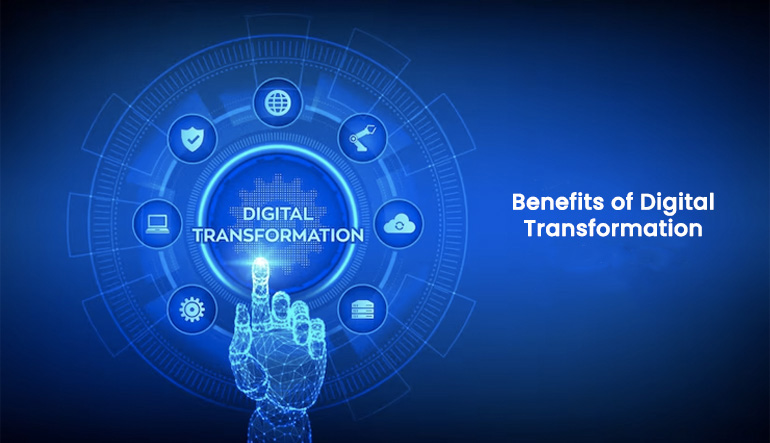In today’s world, where things change quickly, the idea of “digital transformation” has become a key driver of business growth and innovation. As technology keeps getting better at a rate that has never been seen before, companies have to change and adapt to stay competitive and relevant.
Do you know? As per reports, the digital transformation market size is projected to grow at a compound annual growth rate of 19.1%, from $521.5 billion in 2021 to $127.5 billion in 2026.
Let’s go deeper into digital transformation and look at its benefits and key strategies for making it work.
So, What is Digital Transformation?
Digital transformation is when digital technologies are deeply integrated into all parts of a business, changing how it works, interacts, and gives customers value. This holistic approach means rethinking processes, services, and products to make the most of technologies like artificial intelligence, data analytics, cloud computing, and the Internet of Things (IoT).
What are the benefits of Digital Transformation?
In a time when technology is the main driver of progress, businesses of all sizes can benefit from digital transformation in many ways. This shift in strategy toward integrating digital technologies into different parts of operations changes how things work.
Let’s look at some of the most important benefits of digital transformation:
Enhanced Operational Efficiency:
Processes are made more efficient through digital transformation by using automation, data analytics, and cloud computing. This leads to streamlined workflows with less manual work and fewer mistakes. By getting rid of unnecessary tasks, employees can focus on things that add value, which improves the overall efficiency of operations.
Improved Decision-Making:
Decision-makers can make better choices when they have access to real-time data and advanced analytics. Data analysis gives businesses the information they need to predict market trends, find opportunities, and respond quickly to problems. This approach is based on data and sets the stage for strategic growth and new ideas.
Empowered Customer Experiences:
In the digital age, digital transformation is all about knowing what customers want and giving it to them. By using data analytics, businesses learn more about how customers act, what they like, and where they have problems. This information makes it possible to create personalized experiences, customized solutions, and better ways to connect with customers.
Accelerated Innovation:
Using digital technologies helps organizations build a culture of innovation. By encouraging people to try new things and think creatively, businesses can come up with innovative products and services that meet the changing needs of the market. Companies stay relevant and competitive by always looking for new ways to do things.
Agility and Adaptability:
In a business world that changes quickly, agility is key. Businesses can respond quickly to changes and disruptions in the market when they have the tools to do so. Teams can iterate on projects using agile methods, which lets them respond to customer feedback and stay ahead of the competition.
Effective Resource Utilization:
Digital transformation optimizes resource allocation through predictive analytics and AI-driven insights. This results in the efficient utilization of manpower, technology, and financial resources. As a result, businesses can maximize ROI and allocate resources where they are most needed.
Improved Employee Engagement:
Digital tools make it easier for employees to work together, talk to each other, and share what they know. It helps people feel like they belong and are involved, even on teams that are far apart or made up of different kinds of people. Employees are happier when they can use the latest technologies that make their jobs easier.
Global Market Reach:
Businesses can reach people all over the world by using digital platforms and online channels. This opens the door to new markets, customer groups, and ways to grow. Digital transformation works best when it can go beyond geographical boundaries.
Data Security and Compliance:
As part of digital transformation, strong cybersecurity measures are put in place to protect sensitive information. These steps protect both customer information and the assets of the company. Digital tools also make it easier to follow rules about protecting personal information.
Sustainable Practices:
Digital transformation often means using less paper, saving energy, and making the supply chain run more smoothly. This commitment to sustainability is in line with how consumer tastes are changing and helps build a good image for the brand.
What is the significance of Digital Transformation?
It is more important than just adopting new technology because it involves a shift in strategy that affects every part of how businesses run, innovate, and connect with their stakeholders.
Here is the profound significance of digital transformation:
Staying Ahead in the Technology Solution:
In a world where technology changes quickly, it’s important to stay ahead of the curve. Businesses can be more open to change and take advantage of new opportunities when they go through digital transformation.
This flexibility helps companies stay relevant and competitive, even if the market changes or customers’ tastes change. By getting ready for the digital age, businesses put themselves in a position to be leaders who can handle uncertainty and drive growth.
Enhancing Customer Experiences:
At the heart of digital transformation is a firm commitment to making things better for customers. The modern consumer wants easy interactions, services that are tailored to their needs, and solutions that work right away.
Businesses can learn a lot about how customers act, what they like, and where they have problems by using digital tools and data analytics. With this information, it’s possible to create custom experiences that go above and beyond expectations, build brand loyalty, and create long-lasting relationships.
Unlocking Operational Excellence:
Digital transformation changes how resources are used and how processes are run. Automation, AI-driven solutions, and data analytics speed up operations cut down on mistakes made by hand, and make the best use of resources.
This operational efficiency means that costs go down, time to market goes faster, and resources can be put where they will have the most impact. By using digital capabilities, businesses can make their daily operations more flexible and effective.
Fostering a Culture of Innovation:
Embracing digital transformation helps organizations grow a culture of innovation. Teams are told to think outside the box, try out new ideas, and push the limits. This change of mind leads to the creation of new products, services, and business models that meet the changing needs of customers.
As a company makes innovation a part of its culture, it sets itself up to grow and stay relevant in a market that is always changing.
Enabling Data-Driven Insights:
Businesses can use the power of data when they go through digital transformation. Organizations can get actionable insights that help them make strategic decisions with the help of advanced analytics and real-time reporting.
Data-driven insights help us learn more about market trends, customer preferences, and how well operations are running. With this information, businesses can make smart decisions that lead to long-term growth and make them more competitive.
Embracing Digital Ecosystems:
In a world where everything is connected, digital transformation lets businesses connect to bigger ecosystems. When partnerships, collaborations, and integrations work well together, companies can offer customers more complete solutions.
This interconnection goes beyond traditional boundaries, making it possible for businesses to create value through collaborations and co-innovations across industries.


How to Adapt to Technological Changes?
Embracing modernization changes enables us to stay relevant, harness new opportunities, and remain competitive. To effectively adapt to technological changes, consider the following strategies:
Embrace a Growth Mindset:
Develop a growth mindset that sees problems as chances to learn and improve. Approach changes in technology with a sense of wonder and a willingness to learn new skills. Know that getting used to new technologies is a long process that requires you to keep learning and changing.
Stay Informed:
Keep up with changes and trends in technology that are important to your field. Read tech blogs regularly, go to industry conferences, and participate in online communities to stay up to date on the latest changes. If you know what you’re talking about, you can make smart decisions about which technologies to use.
Invest in Continuous Learning:
Commit to learning for the rest of your life to keep up with changes in technology. Sign up for online courses, go to workshops, and join training programs that teach the skills you need. Online learning platforms and industry certifications are both easy ways to learn something new.
Start Small and Experiment:
Start with small-scale tests when you’re dealing with new technologies. It makes large-scale adoption less risky and gives you a chance to test the waters. Experimenting is also a great way to learn how technology can be used most effectively.
Foster Collaboration:
Work with your peers, colleagues, and experts to keep up with changes in technology. Having conversations, sharing experiences, and asking for advice can help you see things from a different angle and help you deal with problems better. When people work together, they often come up with new ideas.
Embrace Change Management:
Organizational changes are often needed to keep up with changes in technology. Use change management practices to make sure that transitions go smoothly. Stakeholders can help make the process easier by communicating, getting trained, and having their concerns heard.
Focus on Transferable Skills:
While specific technologies may change, certain skills remain relevant across different tech landscapes. Focus on cultivating skills such as critical thinking, problem-solving, adaptability, and communication. These skills empower you to navigate various technological changes.
Network and Connect:
Networking is a powerful way to gain insights into how others are adapting to technological changes. Attend meetups, join online forums, and connect with professionals in your industry. These connections can provide valuable insights and support.
Embrace Automation and Tools:
Explore tools and automation that can simplify tasks and free up time for higher-value activities. Automation can enhance efficiency and productivity, allowing you to focus on tasks that require human creativity and decision-making.
Be Open to Feedback:
Adapting to new technologies often involves a learning curve. Be open to feedback from colleagues, mentors, or peers who have experience with the technology. Constructive feedback can help you refine your approach and improve your proficiency.
Conclusion
Digital transformation is not just a buzzword; it’s a strategic imperative for businesses looking to thrive in the digital age. By embracing innovation, Application Modernization, enhancing customer experiences, and streamlining operations, companies can position themselves as industry leaders.
The key is to create a culture of constant improvement, flexibility, and a never-ending quest for excellence.
So, as we move through this digital frontier, we should keep in mind that accepting change now is the key to success tomorrow.
FAQs on Digital Transformation
Q: How does digital transformation benefit businesses?
The benefits of digital transformation include streamlining operations, giving customers a better experience, making better decisions, coming up with new ideas, saving money, and more.
Q: Is digital transformation only for large corporations?
No, businesses of all sizes can benefit from digital transformation. It’s about leveraging technology strategically to achieve growth and efficiency.
Q: Is data security a concern during digital transformation?
Yes, data security is a very important thing to think about. As businesses use more digital tools, they need to put cybersecurity measures at the top of their to-do lists to protect sensitive information.
Q: Can digital transformation be implemented gradually?
Yes, digital transformation usually happens in stages. Companies can start with just a few departments or processes and then add more over time.
Q: How can a business ensure successful digital transformation?
For digital transformation to go well, there needs to be a clear strategy, leadership commitment, proper training for employees, and a focus on giving customers what they want.



